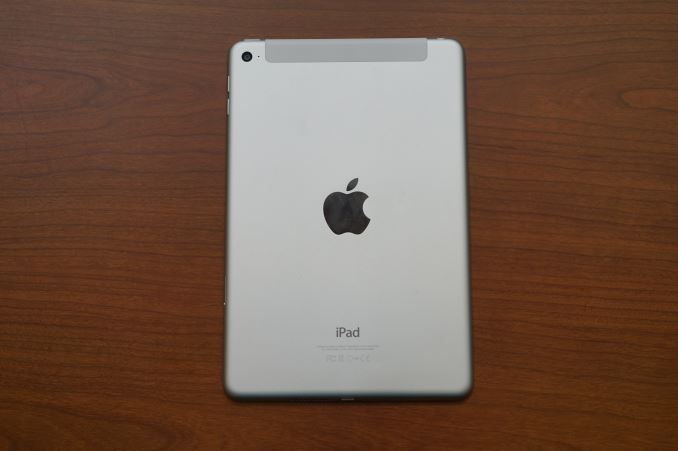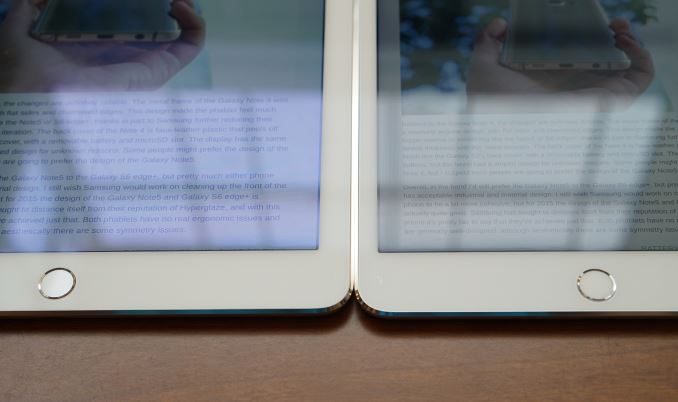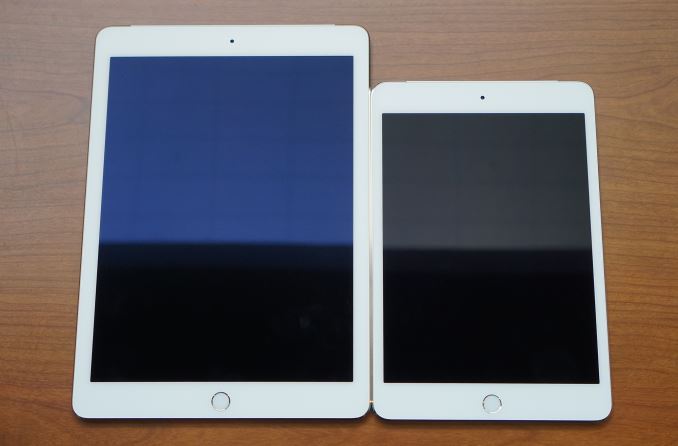The Apple iPad Mini 4 Review
by Brandon Chester on October 28, 2015 8:00 AM EST- Posted in
- Tablets
- Apple
- Mobile
- iPad Mini 4
Final Words
I wasn't very excited about the iPad Mini 3 when Apple announced it last year, as it was just the iPad Mini 2 with Touch ID while the iPad Air 2 was a substantial upgrade from the iPad Air in many ways. The iPad Mini 4 represents an update on the same scale as the Air to Air 2 transition, and it's both highly appreciated and arguably overdue. While many of the changes are actually shared with those made to the iPad Air, some are unique to the Mini either because of its size, or because they occurred on the larger iPad at a previous time. It's worth going over the aspects of the iPad Mini 4 to see whats changed and whether it represents a worthwhile upgrade for existing users or a worthwhile purchase for new adopters.
The build quality of the iPad Mini 4 is as good as the iPad has always been. It's a solid feeling aluminum unibody and there's no flex or creakiness to be found. There isn't really anything other than the Dell Venue 8 that comes close, and I would argue that when you consider design on top of the materials and construction the Mini 4 is definitely the best you'll find in a mini tablet. At 6.1mm thin and 32 grams lighter than the Mini 3 it's also nicer to hold for long periods. I would say that the reduced thickness improves handling more than the small reduction in mass, although the latter can help when holding the tablet for prolonged periods even if it is a pretty small amount.
Performance on the Mini 4 is right where it needs to be as a mini tablet. It's certainly not A8X, but in workloads like web browsing the additional Typhoon CPU core in A8X actually doesn't end up helping all that much. Users who want the absolute best GPU for games and other programs that make use of 3D graphics will want to opt for the Air 2, as while the Mini 4 has good GPU performance for a mini tablet, the GPU in A8X is just really far ahead of everything that isn't powered by an NVIDIA SoC. Apple is clearly aware of the fact that the Mini 4 isn't as capable as the Air 2 for GPU heavy workloads, and this can be seen with the disabled Gaussian blur in the multitasking app tray. While these are definitely things to consider if you need the most GPU power possible, I think most users will find that GX6450 is sufficient for their typical workloads. It's also worth noting that sustained performance in both heavy CPU and GPU scenarios is much farther ahead of competing devices than what is implied by our shorter workload benchmarks that reflect peak performance.
Possibly the biggest contributor to perceived performance has nothing to do with speed or smoothness, but with keeping applications running. The 2GB of RAM in the Mini 4 means that running split screen apps is not a problem, and Safari tabs are no longer killed once you switch to another app or open more than a few at a time. I've mentioned this before, but I think the 2GB transition really should have happened with A7. Regardless, it's finally here now, and that's good news for anyone looking to upgrade or to buy a new iPad.
Next up is the display. This is by far the biggest improvement made going from the Mini 3 to the Mini 4. While Apple was able to make the transition to a Retina display with the second iPad Mini, they had to limit the display's color gamut to do so. This was because of the greater power required by LEDs that had the necessary spectral output to cover the sRGB color gamut. Not only that, but the iPad Mini 3 never received the laminated display of the Air 2, which meant higher reflectance, lower contrast, and a more visible display gap. With the iPad Mini 4 Apple addresses essentially every issue with the previous iPad Mini displays. There's now full coverage of the sRGB color gamut, and an incredible level of accuracy. The display stack is also fully laminated, and the anti-reflective coating from the Air 2 has been brought to the Mini 4. Interestingly, the characteristics of the cover glass mean the iPad Air 2 still ends up being slightly more usable in the sun, but the Mini 4 is still greatly improved compared to its predecessor.
As far as the camera goes, the 8MP rear-facing camera is one of the best on a tablet, and it's a big step up from the 5MP sensor on the last iPad Mini. It's certainly not at the level of the great cameras in devices like the Galaxy S6 or the iPhone, but to take a quick photo in decent lighting it'll do its job fine. The lens flare issues during video recording really let me down though, and because I live in Canada it's not likely that I'll see the sun again for many months in order to check whether this occurs on the Air 2 or if it's unique to the Mini 4. Josh didn't seem to encounter it during his video tests of the Air 2, and on the Mini 4 it's bad enough that I can't really describe the video recording functionality as usable when it's sunny out unless you're facing away from the sun.
The last thing to talk about is battery life. The battery life in web browsing and video playback on the Mini 4 is within Apple's 10 hour target range, which is a good result because a lot of tablet's I've reviewed lately have fallen very short of their battery ratings, and some haven't been confident enough to advertise 10 hours of battery life in the first place. BaseMark OS II shows that the Mini 4 lasts longer than any of the phones or tablets that we've tested in the past, and the CPU throttles far less than any other tablet which leads to higher CPU performance during prolonged CPU workloads compared to the competition, despite also having class leading battery life. This is something that other manufacturers really need to work on, especially at the high end with a tablet like the Air 2 where there's already a significant performance lead before you even factor in that Apple's SoCs throttle less.
The iPad Mini 4 is a long deserved upgrade from the hardware platform that shipped with the Mini 2, and it really makes for a great mini tablet. I do have some uncertainty about the future of the small tablet. From conversations with a few friends it's clear to me that there are groups of people (particularly students) who like the small form factor because it's like carrying a single book that can hold digitized version of big, thick, heavy textbooks, and can be handled even when you're also carrying around a bag and whatever other gear you need. However, Microsoft has pioneered a category of large tablets with the Surface Pro, and both Apple and Google are following suit with the iPad Pro and Pixel C respectively. I don't think the small tablet form factor is going to go away, but I think the market is actually shifting back toward the larger tablet form factors after moving in favor of smaller devices in 2011 and 2012 due to the comparatively large and heavy profiles of the full sized tablets available at that time. You can push more performance, and you have more screen space for multitasking and productivity on a larger tablet.
If you're aiming to create some word documents and spreadsheets, and maybe edit some photos or videos, then I would take a look at the iPad Air 2, or upcoming large tablets like the iPad Pro and the recently released Surface Pro 4 and Surface Book. For the users who lean more toward content consumption and activities like light browsing, reading news, checking social media, and playing games, the iPad Mini 4 will prove to be a great device.













98 Comments
View All Comments
Speedfriend - Wednesday, October 28, 2015 - link
Any idea why this uses the 8 and not the A8X? Does that imply the chassis is not capable of dissipating the higher TDP of the A8X?michael2k - Wednesday, October 28, 2015 - link
I imagine they would have needed a bigger battery to offset the performance cost of the faster GPU and additional CPU core. Throw in a bigger battery and you have to make the iPad a fractional bit thicker, maybe 0.7mm, and another 14g heavier.And throw those three changes (more expensive CPU, more expensive battery, heavier iPad) and you need to bump the cost up just slightly, reducing margins just slightly, on top of the changes in the display that already increase the cost, and it makes sense why they sacrificed performance slightly. This is especially true when the A8 is already and still class leading a year later.
ThomasS31 - Wednesday, October 28, 2015 - link
This has nothing to do with cost... its just a decision to keep everything as thin and light as possible to appeal to the fans and consumers.Ivy said not long ago, they could make a thicker iphone to last longer (battery), but they do not want as it will not appeal as much to the consumers as the current thin phones.
Nothing to do with cost or price... just a decision, some of us like, and some of us not. :)
michael2k - Wednesday, October 28, 2015 - link
None of the outward justification is cost, of course, but they have to hew to a budget like everything else in the world. They increased the cost of the SoC, the memory, the cameras, and the screen, as is. Throwing in the more expensive A8X, the battery for said A8X, and the thicker shell to support both means they would have, as you said, lose the design goal of thinner and lighter. So there would be three reasons to stick to the A8:1) Thinner
2) Lighter
3) Cheaper
GC2:CS - Thursday, October 29, 2015 - link
Considering how energy efficient the Apple chips are, het deffinitelly isn't a problem.You has A8, even if a bit underclocked in an 6,1mm iPod touch. There it can almost perfectly sustain it's peak 1,1 Ghz CPU clock and GPU performance. iPad mini is just a much bigger device, there is more than enough room to dissipate heat, even if it would mean an A8X has to throotle a bit more aggressively than in Air 2.
A8X is a three billion transistor monster, it's big, it's pricey and since it's an X there is no stacked memory on it. That might be the reason - all iPad minis used PoP to save space and so I think that a possibility of an X chip in any iPad mini is quite small.
Also it uses a quite lot of power. If you look at that Gfx bench battery life test above, maybe Apple wanted to match them in terms of battery life under load.
And then while mini might be cappable of dissipating enough heat, Apple possibly didn't wanted the temperatures to go that high. iPad mini 4 is found to be rather cool running even under load.
But I doo agree that an A9 would be much better match. Even though it doesn't have 128-bit memory interface (What has it by the way ?) it bassically matches the performance of A8X, while being much smaller and lower powered, much more efficient than even A8.
Apple said that it's an shrunken down iPad Air 2. In terms of battery life, features, design, cameras display yes.
But with smaller size (and less matter to built a tablet from) there has to be compromise somewhere. Apple didn't matched the performance of Air 2, because it would require more advenced tech (A9) to do so in smaller device. But that would make it more advanced than an shrunken down Air 2 in terms of used tech. Bassically they built the best small tablet possible with let's say the same genertion of technology as iPad Air 2.
iPad mini 2 got smaller color gamut, iPad mini 4 got lower performance. And unless Apple invents a way to make those devices bigger from the inside, they can't defy physics.
Pneumothorax - Thursday, October 29, 2015 - link
Here's the thing, the A9 would've been an easy drop in the Mini 4 and would've matched/exceeded the Air 2 in most benchmarks along with giving better battery life and much less heat. Apple is just being Apple - milking the cow for all it's worth.NetMage - Saturday, October 31, 2015 - link
The mini's considerable price drop versus the Air or phone means giving up something.Drumsticks - Wednesday, October 28, 2015 - link
Thanks for the review. I always enjoy reading Anandtech reviews of Apple products. While I'm an Android/Microsoft guy (any hints on when to expect your 6P review? I'm sure it's a ways off but I'd love a hint!), I have a lot of respect for Apple's hardware engineering and SoC design teams. They do really, really great work, and it almost disappoints me that I dislike iOS (and to an extent, Apple. This is an opinion that is fully subjective and not looking to start a fight! There's plenty of reasons to like Apple).Apple has, for the last several years been a major driver of innovation in the whole industry, which is great. It's awesome to see (in my opinion) both Microsoft AND Google doing the same nowadays. All three of the big guys are driving the industry forward, and it's good for us all :D
amdwilliam1985 - Thursday, October 29, 2015 - link
Same here, I recommend Apple products to others(my parents and my brother all use iPhones), but when it comes to personal device, I'll go with Android/Nexus, will be picking up a Nexus 6P soon, when it's available in Hong Kong.ps: Personally, I want to support Google/Alphabet, don't want to give my money to Apple and then have it sit in their bank doing nothing(besides earning interests ;). It's just a personal believe, I believe with great power comes great responsibilities(Apple should be doing more to help the [tech] world). Luckily, there are always companies like Google who pushes on with crazy projects like Project Loon, Project Fi, Project Soli, Project Jacquard and etc...
I watch Apple WWDC and Google IO live every year, Google's event is just so much more exciting and inspiring to the tech geek in me. Apple's show is more about how they are the best and if you can't join them, then you're a loser kind of show, lol.
Knowing my money helps Google to help improving the world/tech helps me sleep better at night, lol.
lucam - Wednesday, October 28, 2015 - link
The A8 is still a good decent Soc from what I can see and I have a suspicion that in the Apple TV for not having similar thermal constrains and no battery it can go even faster...